Hey friends. I hope you’re having a good day today, listening to a good tune, maybe getting a little sunshine on your face.
Recently I had the pleasure of being part of a retreat with Dr. Frank Lipman up at Menla. Our team of Be Well Health Coaches spent a few days up there with a corporate group of about 15 people, coaching them on some of our philosophies on nutrition. I’ve been working with Dr. Lipman for almost 2 years now, and I graduated from IIN 4 years ago – but I continue to learn so much from him, his patients, and the other health coaches every day.
One thing I realized after being at the retreat? Not everybody spends all day obsessively learning about nutrition like we do.
Sometimes I get in this little bubble of living in the health and wellness world, and certain things I do every day (like reading ingredients labels) don’t seem “important enough” to blog about. When I first started blogging I had such a beginner’s mind – I was like HEY OMG LOOK, COCONUT WATER EXISTS! And now it’s like I need to have the most phenomenal thing to share before I sit down to write. Anyone else feel that?
If you’re in the profession of sharing any kind of knowledge, I think it’s good to put yourself in a beginner’s mindset, and just share more. Don’t assume everyone already knows everything that you know. That assumption is such a major killer of putting out content that might really help people. Really! I’m saying this to myself, mostly, but I assume a lot of you feel the same. Someone once said to me, “don’t hoard your gifts.” Share things.
One of the main questions people had at the retreat? How to read ingredients labels.
You guys, the ingredients label struggle is REAL! It can be a super confusing thing.

When we look at a Nutrition Facts Label, we’ve been taught to look at calories, fat grams, percentages of daily intake of vitamins, and basically everything EXCEPT for….the actual ingredients. It’s like taking an advanced course in physics just trying to decipher how to read one of those labels.

Here are the 3 things that I personally look at when I’m deciding whether or not to put a food into my body:
1) FIRST TEST, ALWAYS: THE INGREDIENTS LIST.
The ideal thing is to buy stuff that has NO ingredients list. Things that are just an ingredient on their own. Spinach. Garlic. Eggs. Squash. You get it.
But let’s say you’re buying something in a package. Here is an example of what a typical ingredients list might look like.
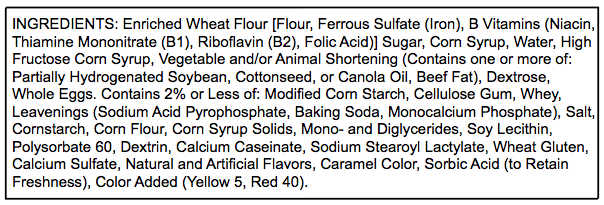
Ok, this is a Twinkie label, so it might be an extreme example, but most packaged foods will look something like this. As you can see, there’s a million ingredients, including high fructose corn syrup, added colors, preservatives, hydrogenated oils, artificial flavoring and…beef fat? (Beef fat isn’t actually the thing that disturbs me the most about this list, but still, wtf?)
This is the type of label where you don’t even need to look at the “Nutrition Facts” section. One look at the ingredients and you know it’s not food.
Whatever you see on the ingredients list is going into your body and is becoming your cells and affecting your health and vitality. It doesn’t matter if it says 2% or less, it’s still in there. If your boyfriend says he only cheats on you 2% or less of the time, are you ok with that? Don’t cheat on yourself!
You might be thinking “Yeah, but that’s a Twinkie. We know that’s not healthy.” You’d be surprised though – check the labels of your whole wheat bread, “healthy” crackers, etc. You’ll probably see something similar. It’s not food.

2) SECOND TEST: SUGAR CONTENT
Ok, so let’s say you find a product that passes test #1, the ingredients list. An example — a Larabar. Let’s go with the Snickerdoodle Larabar. (BECAUSE THAT EXISTS!) I’ve never tried it but man, I want to ASAP!
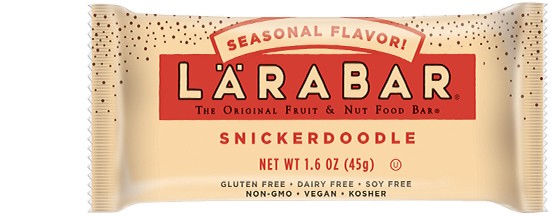
 This product passes test #1 because all of the ingredients are recognizable foods. Dates, cashews, almonds, cinnamon, sea salt, vanilla extract. I can picture all of those things. Score!
This product passes test #1 because all of the ingredients are recognizable foods. Dates, cashews, almonds, cinnamon, sea salt, vanilla extract. I can picture all of those things. Score!
This is when I turn it over and check out the SUGAR.
Now, the label is super small on the Larabar site, but I can tell you that it says 17 grams of sugar.
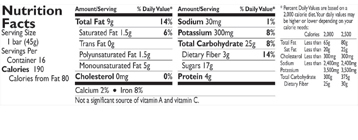
To give you some perspective, 4 grams of sugar = 1 teaspoon.
So 17 grams is a little over 4 teaspoons of sugar.
As far as how many grams of sugar we should be eating in a day, everyone’s gonna have something different to say. Some people can tolerate more added sugar than others, especially if you lead a highly active lifestyle (just make sure it’s coming from healthy, real food sources, not processed crap).
In Sarah Wilson’s I Quit Sugar book, she recommends 5-9 teaspoons of sugar per day (20-36 grams) as the max.
The AHA (whether or not the AHA is where you want to get your info, I don’t know, but some people like hearing “official” recommendations) says close to the same — 6 teaspoons per day (24 grams) max for women and 9 teaspoons per day (36 grams) as the max for men.
It’s not an exact science and everyone is different!! But if we’re just using these numbers as a loose guide, and estimating between 20 and 40 grams of sugar per day as the max, about 2 of these larabars and you’re done.
Just something to think about. Would I still eat this larabar? Of course. I just wouldn’t think of it as a “eat them all day” type of thing just because the ingredients are legit. Make sense?
3) THIRD TEST — SERVING SIZE
Once a product passes test #1 and test #2 (ingredients are actual foods, sugar content isn’t crazy), I check the SERVING SIZE. The reason I do this is to see the TOTAL amount of sugar in the product. In the case of the Larabar above, serving size is 1 bar, so 17 grams of sugar is the total amount. If the serving size said “1/2 a bar” — you know there’s really 34 grams of sugar in it.
This is something that is very easy to miss, especially if you’re getting a beverage. Let’s take the example of Suja Juice – a brand I love, and one that you may see at your local grocery store.
Let’s take a look at their Fiji Green Juice.
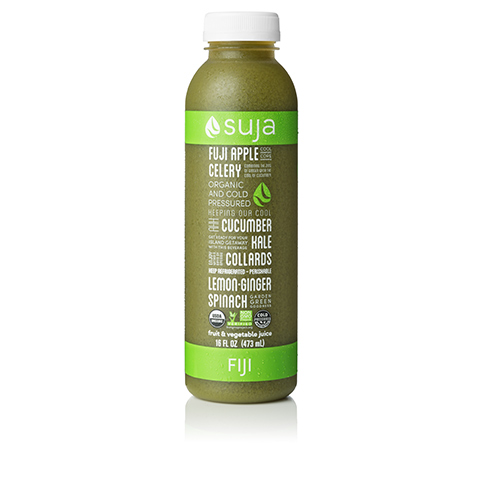
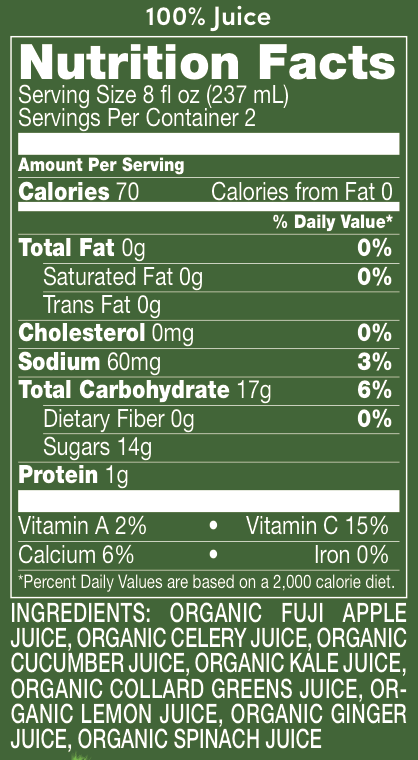
Ingredients? Legit!! Sugar = 14 grams. But…the servings per container = 2.
This means you’re getting 28 grams of sugar when you drink one of these.
Yes, you’re getting the sugar from apples, and with the Larabar you’re getting the sugar from dates — so it’s definitely a better choice than something with refined sugar, high fructose corn syrup, etc. But if you’re watching your sugar intake, it’s something to pay attention to.
In my opinion, you’re better off finding a drink with less sugar — like Suja’s Twelve Essentials (my favorite!) which has a total of 8 grams.
Start checking your labels, it’s so interesting to see.
Ok, that’s my 2 cents on ingredients labels.
1) Ingredients list. 2) Sugar content. 3) Servings per container.
I know some people look at all different things, whether you’re an athlete, going for more protein, you have allergies, you’re on a specific type of diet, etc. This stuff is just the baseline (for me). I’d love to hear how you look at ingredients labels. :)
Now, I officially release you into the wild, my dear supermarket sleuths. If anything is confusing about this, lemme know and I’ll try to clarify.
Hug.
Great book on why we shouldn’t be afraid of fat

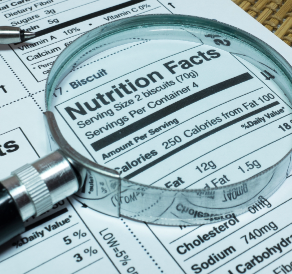

Allison says
Thank you for this article. It is so helpful that you narrowed down a few key areas to look at on labels. I will definitely share this information with others!
jenny sansouci says
Allison – thanks so much for reading! Glad you found it helpful. :) Those labels can be tricky.
Mallory says
So very helpful. I just started a diet makeover last week so this came at the perfect time. Thank you
jenny sansouci says
Awesome! Good luck. :)
Kelsea says
No matter what the topic, I love your writing style and blogs. Wisdom filled and info packed! Thank you for sharing xox
jenny sansouci says
Thanks Kelsea!! <3
Barbara Fisher says
As always, so clear and well written! Great information in a “tiny bite”!
jenny sansouci says
Thank you!! So glad you found it helpful. :)
Hadley Gustin says
This is such a fabulous post, Jenny, and I think it’s really beneficial for a lot of people including me. Even though I am super health conscious myself, it’s great to have a go-to list of the essentials to look for when reading ingredients labels. Any time you can simplify something, life is so much better. :)
Thank you for sharing. I also totally agree with your first sentiment that it never hurts to share what you know no matter how commonplace and mainstream it may seem to you. Honestly, when it comes to your blog, you could type out the alphabet as a blog post, and I would still read it. I’m just such a fan of yours, and you always produce great content that is fun and fascinating to read.
As always, I look forward to many more fabulous future posts from you. ;)
All the Best,
Hadley
jenny sansouci says
Hadley – thank you so much for this comment – it made my day. Really. :) I truly appreciate all your support. Hugs!
martello says
How about sodium? Looks like they put tons of it everywhere… ;/
jenny sansouci says
If you’re eating mostly unprocessed foods you shouldn’t be consuming much added sodium, but yes, that’s definitely something to look for on pre-made soups, packaged snack foods, etc.
Deb says
Good article about labels and paying attention to what you are buying. One medjool date has 16 grams of natural sugar. The hope is with the new food label requirements that manufacturers will be required to list “added sugar” as well as the “natural sugar”. Then we will know the sweetness that nature gives us vs the sugars that manufacturers add to get us to eat more. Go here to see the proposed changes: http://www.fda.gov/Food/GuidanceRegulation/GuidanceDocumentsRegulatoryInformation/LabelingNutrition/ucm385663.htm
jenny sansouci says
Thank you! Very interesting and would be cool for them to add to the labels. Personally I would stay away from foods that have any added sugars unless it comes from a natural source anyway (like honey or maple syrup). So if it has cane sugar or sugar or corn syrup listed as an ingredient I would automatically not buy it.
Carrie says
This was very helpful, Jenny. Thank you!
jenny sansouci says
Thanks for reading, Carrie! Glad you found it useful.
Vanessa says
Solid advice & the beginner’s minder reminder was right on point for me today. Thanks!
jenny sansouci says
Awesome! Thanks, Vanessa. :)
Amruta @Kale and Brownies says
This post was SO helpful! I just sent it to several friends and family. Thanks Jenny!
Alyson says
Jenny first I want to thank you for the reminder to honor the beginners mind. I totally needed to hear this. I often sit down to blog and feel like my topics should be more serious and need more facts. Second I love your break down it was super helpful. I’ve been looking at ingredients and sugar for about two years now but I totally forget to look at serving size…doh! LOL here’s to always learning something new. Thank you!
Chelsea says
I enjoyed this post and I will definitely be sharing it!! I know what I look for when I buy products, but so many people are lost and confused. I like how you broke everything down and made it easier. Lovely blog too!! :)
xoxo,
Chelsea